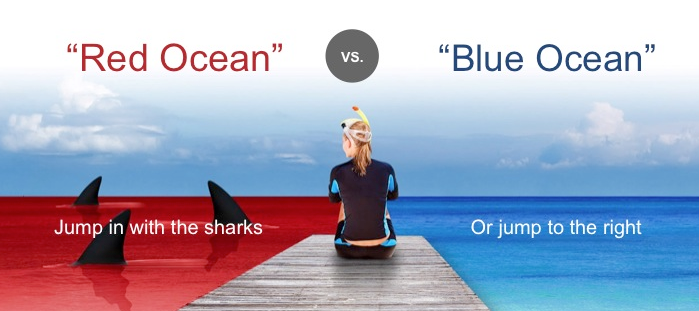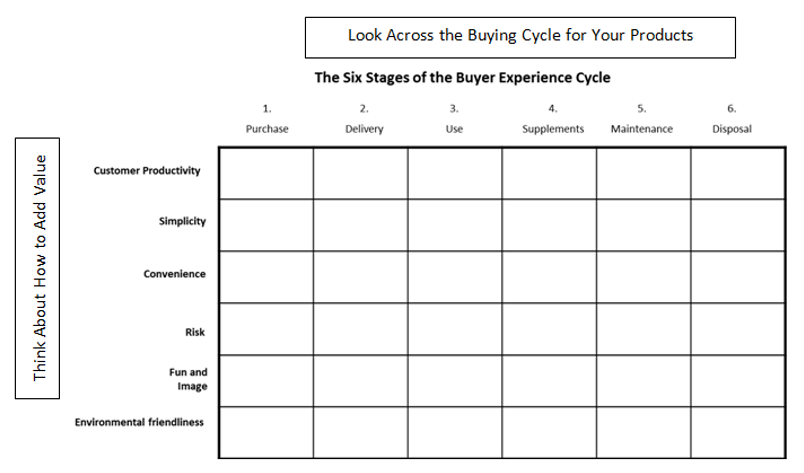We recently completed our 300th workshop on “Change Matters: How to Find New Market Space.” These workshops are essentially about how to craft the right growth strategy for your organization at a particular time in its development. One of the major themes we discuss is Blue Ocean Strategy® (BOS), a revolutionary approach to business growth that offers a fresh way to open new market space.
We are Blue Ocean Strategists and have found that while other strategies can be very useful ways to tackle stable markets, BOS is invaluable for the rapidly changing business environments facing companies today. By using the proven methods of Blue Ocean Strategy, we help companies achieve three major strategic goals:
- Open new market space—to capture nonusers and unmet needs
- Become a value innovator—no longer just an incrementalist
- Make the competition irrelevant—rather than trying to out-do it
In previous blogs I described the first two steps in crafting your own Blue Ocean Strategy:
- How To Find Your Blue Ocean Strategy®: Step 1 where I discuss visual awakening and how you need to step back and see your current strategy as it is today.
- How To Find Your Blue Ocean Strategy®: Step 2 where I explain where and how to go visually exploring to better see, feel and think about potential new market space that might be all around you.
Next step: Be the solution your customers are looking for
Today I want to discuss Step 3, namely, how to put your nonusers and their unmet needs together into a potentially powerful new market strategy—Blue Ocean-style.
The goal: For you to learn how to open a new market space, adapt to changing times and add value in innovative ways. For example, the situation that is causing you to tell customers “We don’t do that” may be exactly what you need to start doing! When you push into new markets, often those new opportunities are right there waiting for you.
First, get some key information
The essence of creating a Blue Ocean Strategy is grounded in the premise that you lack information about two big areas of opportunity:
- Nonusers—those customers who could use you but never think of you, refuse to use you, or only occasionally choose your solutions.
- Unmet Needs—where are those pain points and unmet needs where people perform “go-arounds” because they can’t find a good solution.
Where are those non-users with unmet needs?
Often they are right in front of you. One way to find them is to observe their actual experiences when they are searching for a solution and see if you can make yours work for them.
To better understand these pain points, we use the Buyer Experience Map:
On the left horizontal axis are the Six Levers illustrating how could you add value in an innovative way and make it easier for potential new customers to buy and use your products more easily.
The one shown here is generic; make yours specific. This one begins with where and how people and companies search for a solution to their problem. From left to right on the vertical axis, it maps out where and how they purchase a product, how delivery takes place, how they use a solution/product, how they find/buy supplements or maintain it, and how they dispose of it.
For your current customers, map out the buyer experience as you believe it is today
Ask yourselves and your team how you can improve your business model by making:
- The customer more productive—this might be a strong opportunity for you
- Buying your solution more simple—simple sells better than you think
- Using your solutions more convenient—regardless of what you offer, convenience can be a big differentiator
- It less risky to chose you—take out or diminish the risk and you can add real value
- Your solutions more fun and even an adventure—how you can add more fun and adventure across the Buyer Cycle
- Your products/services more environmentally friendly—this does matter and it could open a big market space
Next, think about pain points across the Buying Cycle (all those things that keep someone from finding your products/solutions, buying them, using them, replenishing them, and even disposing of them). Once you have mapped it out, go down each column and figure out what pain points a potential user might have along their buying cycle. Where could you help them find better ways to solve their problems?
Test your hunches
Once you have identified what you think are the major pain points, take your map out into the marketplace and find out if you are right. Where do customers have trouble finding what they need? Is using your product more complex than you thought? Can they easily dispose of what you are selling them?
Now for the most important step: How could you rethink your current business model to include better, more innovative solutions that could open a new market for you, differentiate you from competitors, and make them irrelevant? This is what Blue Ocean Strategy is all about!
Now imagine the same scenario for nonusers who could be future customers if only you could better understand what their real needs are. How could you create demand for your new innovative solutions among this population?
Two client stories to share
EAC/Integrated Power Solutions

You can read more about EAC’s story on our website at Stories2Share.
Laclede Chain
Another of our clients, Laclede Chain (also detailed in my book), was in a similar situation. Its CEO, Jim Riley, discovered that his customers were asking for all types of specialized chain, not just one. When he listened to incoming calls to the company switchboard, he realized that his customer service person was saying: “No, we don’t sell that,” a lot more often than she said, “Yes, we do that.”
His company’s prospective clients were having a difficult time finding what they were looking for—they had pain. Since Laclede Chain only manufactured traction chains for snow, he never paid attention to requests for other types of chain. Suddenly, he saw that people were searching for something he could provide if he repositioned the company to offer a variety of chain. This “aha” moment was the catalyst that grew his company in new directions.
The moral? The way forward is all around you. Can you see it?
Think about the possibilities that are all around you, just waiting for you to “see” them. Blue Oceans are typically not far from you. You just need to see those new market opportunities with fresh eyes. After one of our workshops, one CEO put a person in charge of handling all the “we don’t do that”s to determine if they were one-offs or potential big ideas. Get your team engaged by challenging them to listen with open minds to better hear what your clients ‘unmet’ needs are and how you can solve them.
Is your Blue Ocean waiting for you?
It might seem hard to believe but those big blue oceans of opportunity really are there. You just have to look for them with different eyes. But don’t stay in your office and imagine it. Once you have filled out the Buyer Experience Map, get out and actually walk through the buyer´s experience. Try to buy something from your company. Then try to use it. Experience all the moments of satisfaction, problems, discomfort or outright pain.
Next, in Step 4, I’ll discuss how to convert nonusers into loyal fans who will follow you for solutions they never imagined were available.
Want to go deeper? This white paper is for you.
With Blue Ocean Strategy, you stop competing for the same customers in a “red ocean” of bloody competition, and instead, make the competition irrelevant. Our white paper, “Time To Find Your Blue Ocean Strategy®?” explains how.
And for an even deeper dive into Blue Ocean Strategy, check out our video.
Are you ready to embark on your own Blue Ocean Strategy?
Are you ready for a Blue Ocean Strategy instead of slugging it out in your old red ocean? We have done over 270 workshops for CEOs and companies that need or want to find their Blue Ocean Strategies—in all types of industries in the US, Canada and around the world. Perhaps we can be of help to you and your organization. Please contact us for a free consultation. We love to talk Blue Ocean!
From Observation to Innovation
Andi Simon
Corporate Anthropologist | President
Simon Associates Management Consultants
To learn more just reach out to: info@simonassociates.net
Author: “On The Brink: A Fresh Lens to Take Your Business To New Heights”






